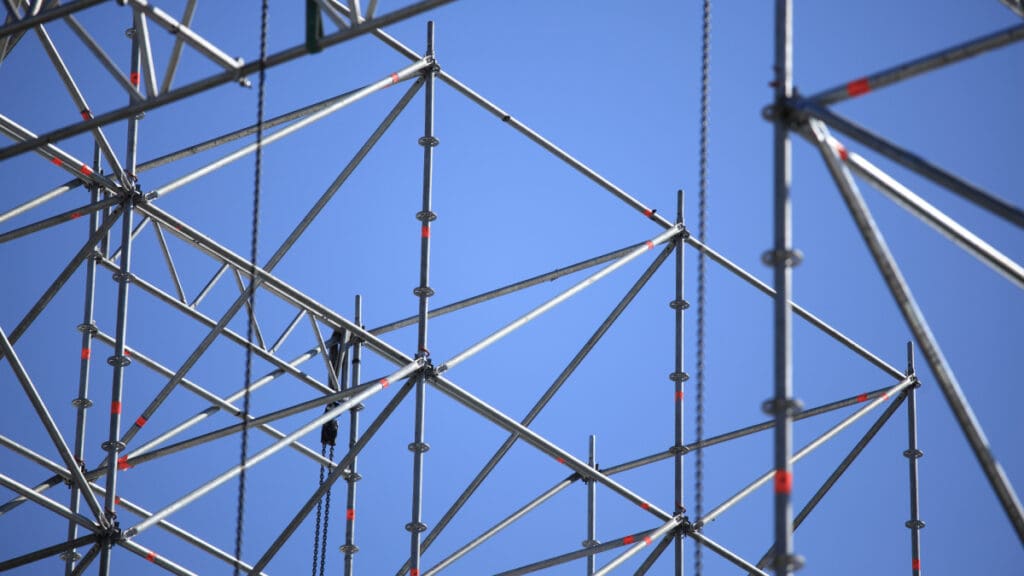How to Improve Your Bid-to-Win Ratio & Win More Scaffolding Projects
Introduction Every scaffolding company knows the pressure of submitting bids (tenders) under looming deadlines, narrow profit margins, and high competition.… Read More

Scaffolding is an integral part of any construction process, and the ideal choice of scaffolding should create safe and easy access for construction personnel. Of the many types of scaffolding, system scaffolding is increasingly popular around the world, and like other styles, system scaffolding is no exception when it comes to the importance of proper design practices.
Effective design results in a robust scaffold with three benefits:
In this article, we look at the types of system scaffolding, the design challenges that scaffolding designers may face, and tools that pros use to overcome them.
Also known as modular scaffolding, system scaffolding utilizes preset vertical, horizontal, and diagonal posts and tubes. The most common types of system scaffolding used today are Ringlock (or pinlock), Cuplock, and Kwikstage, with proprietary styles like HAKI and OCTO also gaining popularity.
Ringlock scaffolding is a versatile, capable system that utilizes multiple ledgers, clamps, guard rails, connectors, stair stringers, steps, and adapters. It offers a unique rosette arrangement which can be self-locked by adaptive wedge using a hammer allowing up to 8 connections present. It is quick and easy to assemble and provides a higher degree of flexibility with a number of angles to lock the notch.
Cuplock scaffolding is highly desired for its capability to hold large amounts of weight. Often known by the proprietary “Cuplok” name, the Cuplock system is a fully galvanized system that is highly resistant to rust and weather damage, and can be 20% lighter than regular steel tubes. A unique coupler locking mechanism allows for quick and flexible installation.
Kwikstage scaffolding, as the name suggests, is a quick set-up system. Six basic components make up Kwikstage scaffolding; standards, ledgers, transoms, braces, base jacks, and boards. The ability to add other components like hop-ups (side brackets) gives it the flexibility to fit any shape – highly useful in situations where the facade of the building is complex. Kwikstage can adapt to difficult terrain too.
“Proprietary scaffolding” is a general term to describe scaffolding with unique connection points. It relies on the same fundamental concepts of vertical members, horizontal members, diagonal members, and decking. There are more widely available styles, which differentiate themselves with features like lighter weight, quicker assembly, or unique, specialized accessories. Each system may differ based on the manufacturer. Some examples of proprietary scaffolding are HAKI, OCTO, and Safway Systems.
System scaffolding is a modern approach to access that requires modern design solutions. Conventional methods of design may be insufficient to deliver results quickly and effectively. Let’s explore some issues that may arise when designing system scaffolding with traditional or non-specialized methods.
Designing in 2D is a laborious and error-prone process, and the potential for interference and fit-up errors at construction sites can be high. Designing in 3D reduces the risk of errors with clearer visualization of designs. Better yet, integrating Augmented Reality and Virtual Reality software improves accuracy significantly.
Professional computer aided design (CAD) is estimated to take 80 hours to learn basic designs. This translates to higher costs in employing CAD designers, especially when you consider the additional scaffolding-specific learning required. Alternatively, purpose-built software for designing system scaffolding ensures that even non-designers can create safe and effective scaffold designs.
Designing in theory and materializing the finalize design on-site are not the same thing. It isn’t easy for scaffolding designers to fully understand how the landscape and terrain of job sites affect scaffolding design and safety. Additional training may be needed to create effective designs.
Thankfully, there is a solution to the three design challenges. Deploying industry-specific software like Avontus Designer enables bid-winning scaffolding designs that meet safety requirements while streamlining work processes.
3D, AR, VR – A tool with powerful visualization capabilities is able to highlight any safety issues during the design process. Avontus Designer integrates these features to visualize your designs in minutes. Import readily available plans and walk through them in 3D for faster design completion.
Safety – Safety elements like leg load calculations, bracing, and custom guardrail configurations can be assessed. Easily spot possible areas of failure and inefficient design choices with a digital walkaround. Avontus Designer’s AR and VR features can help you create safe and cost-effective designs that prevent costly redesigns on the job site later.
Inexpensive – Unlike CAD software that requires hours of training, Avontus Designer allows even non-design personnel to operate it. Upload scaffold designs from Designer to Avontus Viewer® and view for free on Windows Desktop, iOS, Android or Microsoft HoloLens. A monthly subscription fee for Designer starts at $169.
Built-in Library – Get access to a plethora of designs for various scaffolding options. Manufacturer catalogues for Ringlock, Kwikstage, and proprietary scaffolding styles are at your fingertips. Export 2D and 3D models to Tekla Structures, BIM packages, PDF, AutoCAD, Navisworks, SCIA Engineer, and Microsoft Office with ease.
Support & Training – No man is an island – we believe in taking care of you throughout your design process. Avontus offers help and support for implementation, training, updates and more. Live phone support ensures you get your design program up and running to best suit your needs.
For a quick look at what Avontus Designer (previously known as Scaffold Designer) can do, check out our short video below.
Click the link below to find out more on how Avontus Designer could help you design safer and more efficient scaffolding.